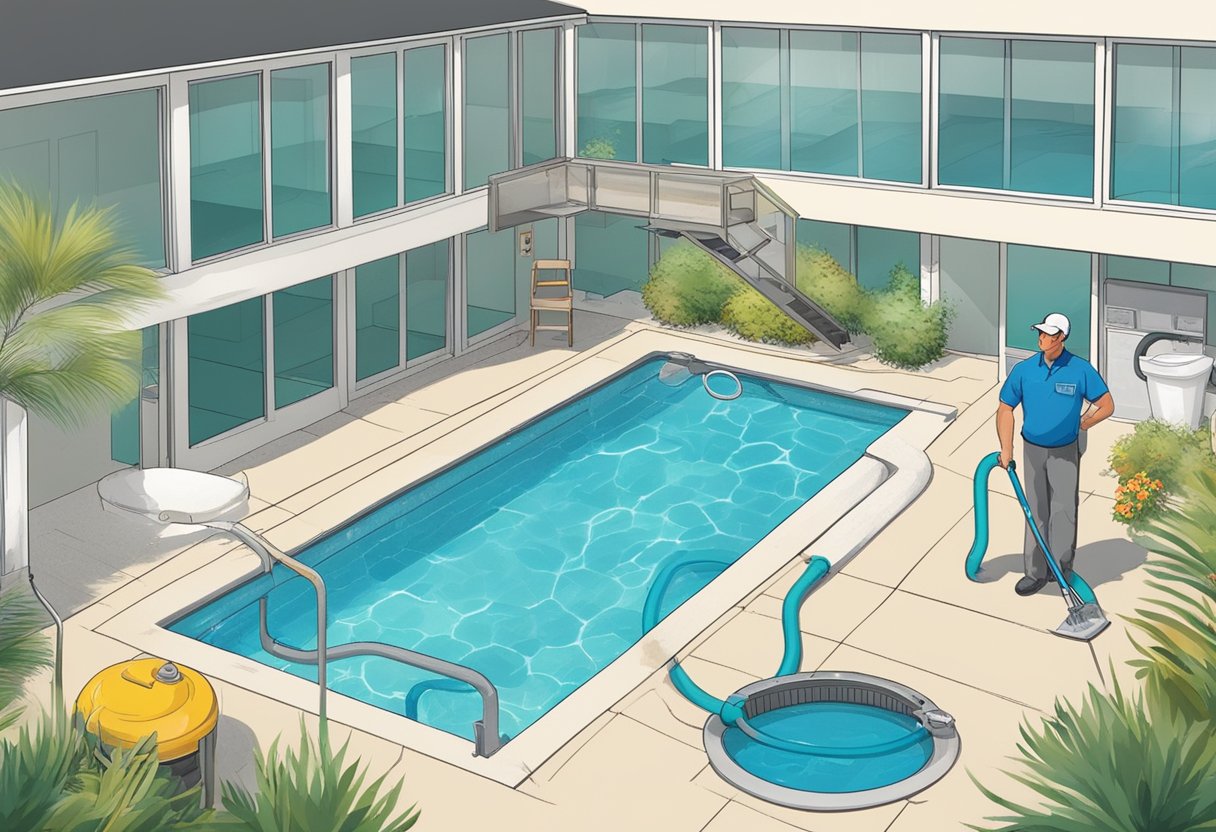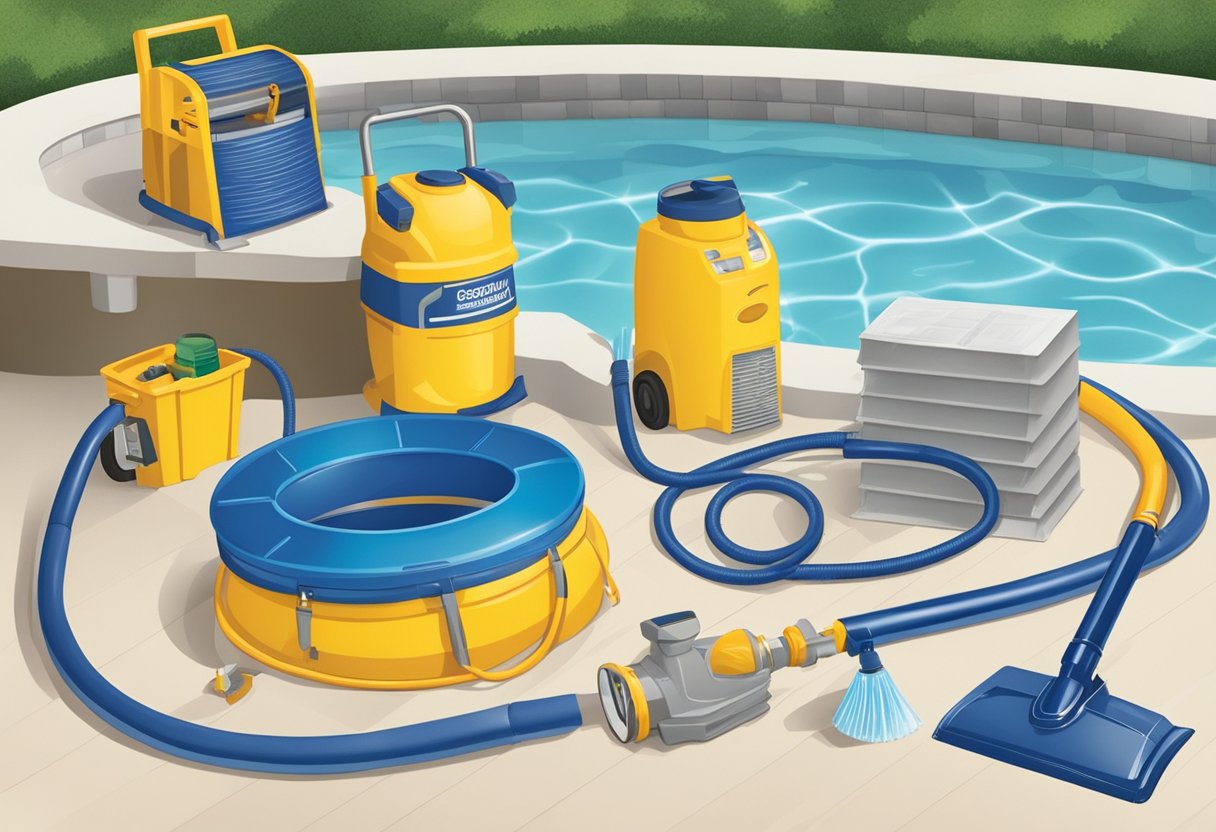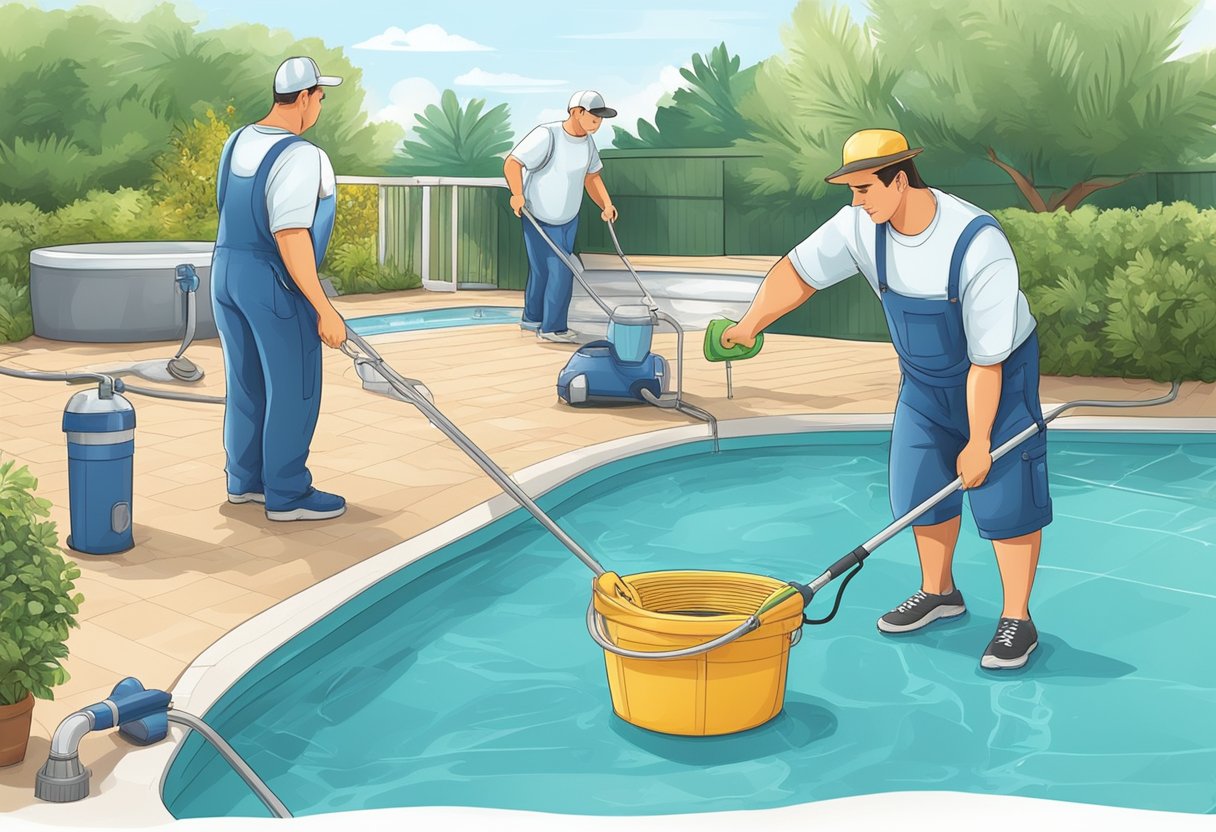Maintaining a pool is not just about keeping it clean and clear. It is also about ensuring that the water is balanced and free of contaminants and pollutants. A well-maintained pool not only provides a safe and healthy swimming environment but also extends the life of the pool hardware. In this article, I will share some tips on how to clean and maintain a pool to ensure that it remains in top condition.

Understanding pool maintenance is the first step to keeping your pool in good condition. It involves maintaining the pool water chemistry, cleaning the pool, maintaining the pool filters, and using pool chemicals. Regular maintenance is essential to ensure that the pool remains clean and safe to swim in. In the following sections, I will provide detailed information on each of these topics to help you maintain your pool.
The importance of pool water chemistry cannot be overstated. It is essential to keep the pH, alkalinity, and chlorine levels in check to ensure that the pool water is balanced and free of contaminants. Regularly cleaning the pool and maintaining the pool filters are also essential to ensure that the water remains clear and free of debris. Using pool chemicals can help to maintain the water chemistry and keep the pool clean. Let’s dive deeper into each of these topics to learn more.
Key Takeaways
- Understanding pool maintenance is essential to keeping your pool in good condition.
- Maintaining the pool water chemistry, cleaning the pool, and maintaining the pool filters are crucial to ensuring a clean and safe swimming environment.
- Regular maintenance and the use of pool chemicals can help to keep the water balanced and free of contaminants.
Understanding Pool Maintenance
https://www.youtube.com/watch?v=UocaSS2Jxmg&embed=true
Maintaining a pool can seem like a daunting task, but it doesn’t have to be. With a little bit of knowledge and effort, you can keep your pool looking crystal clear and inviting all season long. In this section, I’ll cover the basics of pool maintenance, from water chemistry to cleaning and equipment upkeep.
Water Chemistry
Maintaining proper water chemistry is the cornerstone of pool maintenance. The three main components of water chemistry are pH, chlorine levels, and alkalinity. It’s important to test your water regularly to ensure that these levels are within the recommended ranges.
- pH: The ideal pH range for pool water is between 7.2 and 7.8. If your pH is too high or too low, it can cause skin and eye irritation, as well as damage to your pool equipment.
- Chlorine: Chlorine helps to kill bacteria and keep your pool water clean and clear. The recommended chlorine level for most pools is between 1 and 3 parts per million (ppm).
- Alkalinity: Alkalinity helps to buffer the pH level of your pool water. The ideal range for alkalinity is between 80 and 120 ppm.
Cleaning
Regular cleaning is essential to keep your pool looking its best. Here are some basic cleaning tasks that should be done on a regular basis:
- Skim the surface: Use a skimmer net to remove leaves, bugs, and other debris from the surface of the water.
- Brush the walls and floor: Use a pool brush to scrub the walls and floor of your pool to remove any dirt or algae buildup.
- Vacuum the pool: Use a pool vacuum to remove any debris that has sunk to the bottom of your pool.
- Clean the filter: Your pool’s filter is responsible for removing debris and contaminants from the water. Clean or replace your filter according to the manufacturer’s instructions.
Equipment Upkeep
Proper equipment upkeep can help to extend the life of your pool and keep it running smoothly. Here are some tips for maintaining your pool equipment:
- Check the pump: The pump is responsible for circulating water through your pool’s filter and keeping the water clean. Check your pump regularly to ensure that it is running smoothly and that there are no leaks.
- Maintain the heater: If your pool has a heater, it’s important to maintain it properly to ensure that it is running efficiently and safely.
- Check the pool cover: If you use a pool cover, make sure that it is in good condition and that it is securely fastened to the pool.
By following these basic pool maintenance tips, you can keep your pool looking great and enjoy it all season long.
The Importance of Pool Water Chemistry
https://www.youtube.com/watch?v=iImxOdm7hoc&embed=true
As a pool owner, I know that maintaining proper pool water chemistry is crucial to keeping my pool clean and safe for swimmers. In this section, I will discuss the importance of pool water chemistry and provide tips on how to maintain optimal chemical levels in your pool.
Understanding PH Levels
The pH level of your pool water is a measure of its acidity or alkalinity. A pH level of 7.0 is neutral, while levels below 7.0 are acidic and levels above 7.0 are alkaline. It’s important to maintain a pH level between 7.2 and 7.8, as this range is optimal for swimmer comfort and chemical effectiveness.
To test your pool’s pH level, use a pool test kit or pH test strips. If the pH level is too low, add a pH increaser such as sodium carbonate or sodium bicarbonate. If the pH level is too high, add a pH decreaser such as muriatic acid or sodium bisulfate.
Maintaining Alkalinity
Alkalinity is a measure of the water’s ability to resist changes in pH. Total alkalinity should be maintained between 80 and 120 parts per million (ppm). If the alkalinity level is too low, the pH level can fluctuate rapidly and become difficult to control. If the alkalinity level is too high, the water can become cloudy and scaling can occur.
To adjust alkalinity levels, add an alkalinity increaser such as sodium bicarbonate or an alkalinity decreaser such as muriatic acid.
Managing Calcium Hardness
Calcium hardness is a measure of the amount of dissolved calcium in the pool water. Proper calcium hardness levels should be between 200 and 400 ppm. If the calcium hardness level is too low, the water can become corrosive and damage pool equipment. If the calcium hardness level is too high, scaling can occur.
To adjust calcium hardness levels, add a calcium hardness increaser such as calcium chloride or a calcium hardness decreaser such as sodium hexametaphosphate.
Maintaining proper pool water chemistry is essential for a clean and safe swimming environment. By regularly testing and adjusting chemical levels, you can ensure that your pool water is balanced and healthy for swimmers.
Cleaning Your Pool
https://www.youtube.com/watch?v=Lk4dqILgyLQ&embed=true
Keeping your pool clean is essential for maintaining its longevity and safety. Regular cleaning will help prevent the buildup of dust, bacteria, scum, and other debris that can harm your pool’s equipment and swimmers. In this section, I will discuss the three main steps to cleaning your pool: removing leaves and debris, vacuuming your pool, and brushing pool walls.
Removing Leaves and Debris
The first step to cleaning your pool is to remove any floating debris, such as leaves and twigs, from the surface of the water. You can do this using a leaf skimmer, which is a net attached to a long pole. Simply skim the surface of the water with the net, collecting any debris as you go. Be sure to empty the contents of the net into a skimmer basket to prevent it from falling back into the pool.
Vacuuming Your Pool
The second step to cleaning your pool is to vacuum the bottom and sides of the pool. You can do this manually using a pool vacuum or automatically using an automatic pool cleaner. If you choose to use a manual pool vacuum, attach it to a telescopic pole and move it around the pool, cleaning the bottom and sides. Be sure to clean the filter regularly to prevent clogging. If you choose to use an automatic pool cleaner, simply turn it on and let it do the work for you.
Brushing Pool Walls
The third step to cleaning your pool is to brush the walls and floor of the pool to remove any buildup of dirt or algae. You can do this using a pool brush attached to a telescopic pole. Simply move the brush around the pool, scrubbing the walls and floor. Be sure to clean the brush regularly to prevent the buildup of debris.
By following these three steps, you can keep your pool clean and safe for swimmers. Regular cleaning will help prevent the buildup of dust, bacteria, scum, and other debris that can harm your pool’s equipment and swimmers.
Maintaining Pool Filters
https://www.youtube.com/watch?v=sEcN2WiEq_w&embed=true
As a pool owner, maintaining your pool filter is essential to keep your pool water clean and clear. Here are some tips on how to maintain different types of pool filters.
Understanding Backwashing
Backwashing is a process that removes debris and dirt from the filter by reversing the water flow. To backwash, turn off the pump and set the valve to “backwash.” Turn the pump back on and let it run for a few minutes until the water in the sight glass is clear. Then, turn off the pump and set the valve to “rinse.” Turn the pump back on and let it run for a minute to clear out any remaining debris. Finally, turn off the pump and set the valve back to “filter.”
Cleaning Sand Filters
Sand filters are the most common type of pool filter. To clean a sand filter, backwash it first, then turn off the pump and remove the filter cap. Use a hose to wash out the sand from the filter, being careful not to damage the laterals. Once the sand is removed, inspect the laterals for any damage or cracks. If there is any damage, replace them. Then, add new sand to the filter, making sure to follow the manufacturer’s instructions on the amount of sand to use.
Understanding Diatomaceous Earth Filters
Diatomaceous Earth (DE) filters are more efficient than sand filters and can filter out smaller particles. To clean a DE filter, first, backwash it, then turn off the pump and remove the filter cap. Remove the grids and hose them down with a high-pressure hose, being careful not to damage them. Inspect the grids for any damage or tears. If there is any damage, replace them. Then, add new DE powder to the filter, making sure to follow the manufacturer’s instructions on the amount of DE to use.
By following these tips, you can maintain your pool filter system and keep your pool water clean and clear. Remember to backwash your filter regularly and clean it thoroughly at least once a year.
Using Pool Chemicals
https://www.youtube.com/watch?v=CNiv2XfOtys&embed=true
Maintaining proper chemical levels in your pool is crucial for keeping the water clean and safe for swimming. There are several different types of pool chemicals that you’ll need to use on a regular basis to keep your pool in top condition.
Chlorine and Bromine
Chlorine and bromine are two of the most common sanitizers used in pool maintenance. They work by killing bacteria and other harmful microorganisms in the water. Chlorine is the most popular choice, but bromine is often used as an alternative for people with sensitive skin or allergies.
To use chlorine or bromine, you can add tablets or granules directly to the pool water. It’s important to maintain the proper levels of these chemicals, as too little can lead to bacteria growth and too much can cause skin and eye irritation.
Cyanuric Acid
Cyanuric acid is a stabilizer that helps protect chlorine from being broken down by the sun’s UV rays. It’s often added to chlorine tablets or granules to extend their lifespan and effectiveness.
However, too much cyanuric acid can cause problems with chlorine effectiveness. It’s important to maintain the proper levels of cyanuric acid in your pool to ensure that your chlorine is working properly.
Pool Shock
Pool shock is a powerful oxidizer that’s used to kill bacteria and algae in the water. It’s typically used on a weekly basis to keep the water clean and clear.
To use pool shock, you’ll need to add it directly to the pool water. It’s important to follow the instructions carefully, as too much shock can damage your pool’s surface and equipment.
In addition to these chemicals, you may also need to use algaecide and other specialty chemicals to keep your pool in top condition. Always follow the instructions carefully and test your pool’s chemical levels regularly to ensure that everything is in balance.
Additional Pool Maintenance Tips

As a pool owner, I know how important it is to keep your pool clean and well-maintained. Here are some additional tips that can help you keep your pool in top shape:
Maintaining Water Level
Maintaining the water level in your pool is important for the proper functioning of your pool pump and skimmer. If the water level is too low, the pump can run dry and burn out. If the water level is too high, the skimmer won’t be able to do its job properly. Check the water level regularly and add water as needed. If you have an above-ground pool, make sure the water level is at least halfway up the skimmer opening.
Using a Pool Cover
Using a pool cover can help keep your pool clean and reduce the amount of maintenance required. A pool cover can help keep debris out of your pool, which means less skimming and vacuuming for you. It can also help reduce water evaporation, which means you won’t have to add as much water to your pool. If you have an in-ground pool, consider investing in an automatic pool cover for even more convenience.
Hiring Pool Cleaning Services
If you don’t have the time or energy to maintain your pool yourself, consider hiring a pool cleaning service. Pool professionals can take care of everything from skimming and vacuuming to balancing the chemicals in your pool. They can also help you identify and fix any problems with your pool pump or skimmer. Hiring a pool cleaning service can be a great way to ensure that your pool is always clean and ready to use.
Remember, a well-maintained pool is a happy pool! By following these additional pool maintenance tips, you can keep your pool in top shape all season long.
Frequently Asked Questions

What are some essential pool cleaning supplies?
To keep your pool clean, you’ll need a few essential supplies. These include a pool skimmer, pool vacuum, pool brush, pool chemicals, and a pool cover. A skimmer is used to remove debris from the surface of the water, while a vacuum is used to clean the bottom and walls of the pool. A pool brush is used to scrub away any dirt or grime that has accumulated on the walls of the pool. Pool chemicals are used to balance the pH levels of the water and keep it clean, while a pool cover helps to keep debris out of the pool when it’s not in use.
How often should I clean my pool?
The frequency with which you should clean your pool depends on a number of factors, including the size of your pool, the number of people using it, and the amount of debris that falls into it. As a general rule, you should aim to clean your pool at least once a week. This will help to ensure that the water remains clean and clear, and that any debris or dirt is removed before it has a chance to accumulate.
What is the best way to clean a pool?
The best way to clean a pool is to start by skimming the surface of the water with a pool skimmer. Next, use a pool vacuum to clean the bottom and walls of the pool. Be sure to brush the walls of the pool with a pool brush to remove any dirt or grime that has accumulated. Once you’ve finished cleaning the pool, it’s important to balance the pH levels of the water. This can be done using pool chemicals.
What are some common pool maintenance mistakes to avoid?
One of the most common pool maintenance mistakes is failing to clean the pool regularly. This can lead to a buildup of dirt and debris, which can eventually cause the water to become cloudy or even green. Another mistake is failing to balance the pH levels of the water. This can lead to irritation of the eyes and skin, and can also cause damage to the pool itself. It’s also important to avoid using too much chlorine, as this can be harmful to swimmers and can cause damage to the pool.
How do I balance the chemicals in my pool?
Balancing the chemicals in your pool is essential to keeping the water clean and clear. The most important chemical to balance is the pH level of the water. This can be done using a pH testing kit, which will help you to determine the current pH level of the water. If the pH level is too high or too low, you can adjust it using pool chemicals. It’s also important to maintain the proper levels of chlorine and other chemicals in the water.
What steps should I take to properly winterize my pool?
Winterizing your pool is an important step in maintaining its longevity. To properly winterize your pool, you should start by cleaning it thoroughly and removing any debris. Next, you should balance the chemicals in the water and lower the water level to below the skimmer. Finally, you should cover the pool with a winter cover to protect it from the elements. It’s also a good idea to periodically check the pool throughout the winter to ensure that it remains clean and free of debris.
